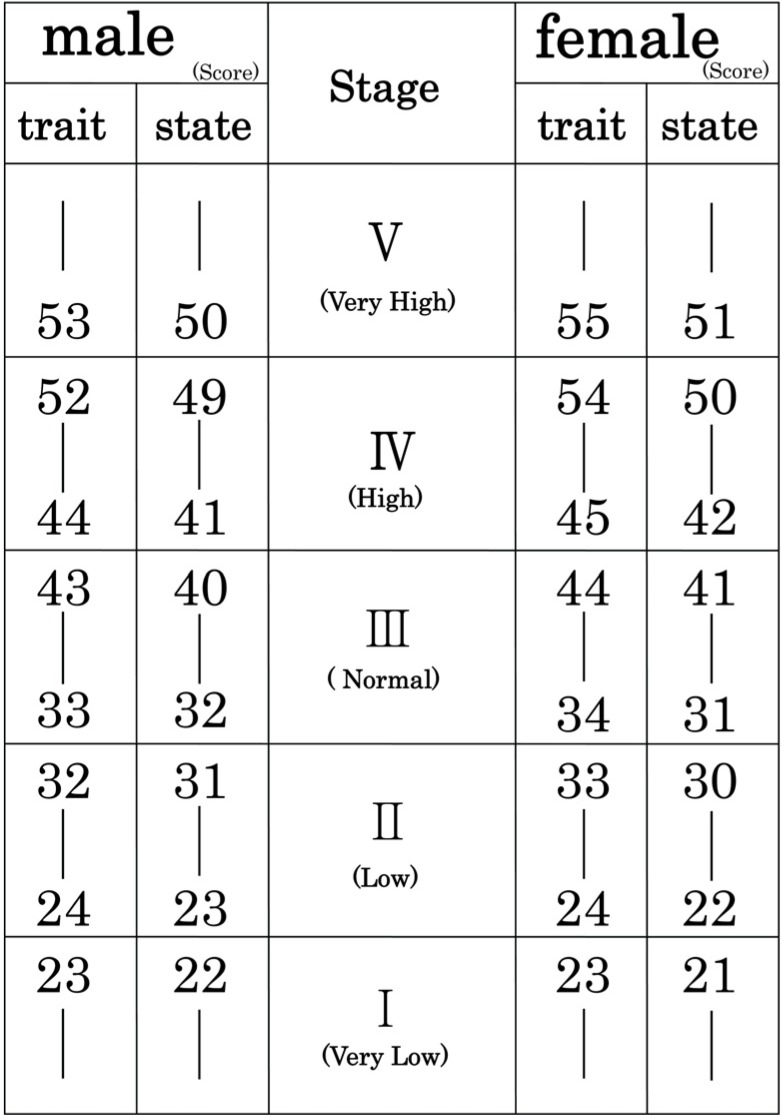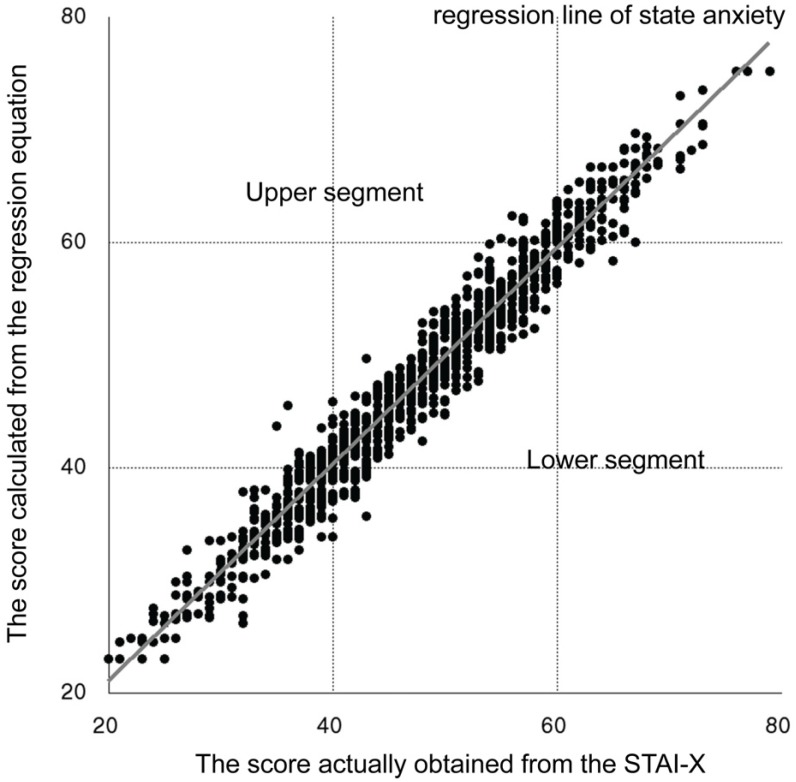J Dent Anesth Pain Med.
2017 Sep;17(3):183-190. 10.17245/jdapm.2017.17.3.183.
Anxiety before dental surgery under local anesthesia: reducing the items on state anxiety in the State-Trait Anxiety Inventory-form X
- Affiliations
-
- 1Department of Oral and Maxillofacial Surgery, Faculty of Medicine, Fukuoka University, Fukuoka, Japan. md140008@cis.fukuoka-u.ac.jp
- 2Department of Mechanical Engineering, Faculty of Engineering, Fukuoka University Fukuoka, Japan.
- KMID: 2390802
- DOI: http://doi.org/10.17245/jdapm.2017.17.3.183
Abstract
- BACKGROUND
It is important to evaluate preoperative anxiety and prepare sedation when performing dental surgery under local anesthesia. Spielberger's State-Trait Anxiety Inventory (STAI) is useful for predicting preoperative anxiety. State anxiety is defined as a subjective feeling of nervousness. Reduction in the number of the state anxiety items (questions) will be clinically important in allowing us to predict anxiety more easily.
METHODS
We analyzed the STAI responses from 1,252 patients who visited our institution to undergo dental surgery under local anesthesia. Multiple linear regression analysis was conducted for 9 groups comprising anxiety level determinations using the STAI; we then developed a coefficient of determination and a regression formula. We searched for a group satisfying the largest number of requirements for regression expression while setting any necessary conditions for accurately predicting anxiety before dental surgery under local anesthesia.
RESULTS
The regression expression from the group determined as normal for preoperative state anxiety was deemed the most suitable for predicting preoperative anxiety.
CONCLUSIONS
It was possible to reduce the number of items in the STAI by focusing on "Preoperative anxiety before dental surgery."
Keyword
Figure
Reference
-
1. Weinstein P, Shimono T, Domoto P, Wohlers K, Matsumura S, Ohmura M, et al. Dental fear in japan: Okayama prefecture school study of adolescents and adults. Anesth Prog. 1992; 39:215–220. PMID: 8250343.2. Marya C, Grover S, Jnaneshwar A, Pruthi N. Dental anxiety among patients visiting a dental institute in faridabad, india. West Indian Medical Journal. 2012; 61:187–190. PMID: 23155968.3. Spielberger C, Gorusch R, Lushene N. Manual for the state-trait anxiety inventory. Palo Alto, CA: Consulting Psychologists Press en;1970.4. Marteau TM, Bekker H. The development of a six-item short-form of the state scale of the spielberger state-trait anxiety inventory (stai). Br J Clin Psychol. 1992; 31(Pt 3):301–306. PMID: 1393159.
Article5. Perpina-Galvan J, Richart-Martinez M, Cabanero-Martinez MJ. Reliability and validity of a short version of the stai anxiety measurement scale in respiratory patients. Arch Bronconeumol. 2011; 47:184–189. PMID: 21420220.6. Fioravanti-Bastos ACM, Cheniaux E, Landeira-Fernandez J. Development and validation of a short-form version of the brazilian state-trait anxiety inventory. Psicologia: Reflexão e Crítica. 2011; 24:485–494.
Article7. Bergua V, Meillon C, Potvin O, Ritchie K, Tzourio C, Bouisson J, et al. Short stai-y anxiety scales: Validation and normative data for elderly subjects. Aging Ment Health. 2016; 20:987–995. PMID: 26055726.
Article8. De Vries J, Van Heck GL. Development of a short version of the dutch version of the spielberger stai trait anxiety scale in women suspected of breast cancer and breast cancer survivors. J Clin Psychol Med Settings. 2013; 20:215–226. PMID: 23104184.
Article9. Nilsson S, Buchholz M, Thunberg G. Assessing children's anxiety using the modified short state-trait anxiety inventory and talking mats: A pilot study. Nurs Res Pract. 2012; 2012:932570. PMID: 22991660.
Article10. Nakazato K, Mizuguchi T. Development and validation of japanese version of state-trait anxiety inventory : A study with female subjects. Jpn J Psychosom Med. 1982; 22:107–112.11. Palmer-Bouva C, Oosting J, deVries R, Abraham-Inpijn L. Stress in elective dental treatment: Epinephrine, norepinephrine, the vas, and cdas in four different procedures. Gen Dent. 1998; 46:356–360. PMID: 9758981.12. Tsuchihashi T, Takata Y, Kurokawa H, Miura K, Maruoka Y, Kajiyama M, et al. Blood pressure response during dental surgery. Hypertens Res. 1996; 19:189–194. PMID: 8891747.
Article13. Kim WS, Byeon GJ, Song BJ, Lee HJ. Availability of preoperative anxiety scale as a predictive factor for hemodynamic changes during induction of anesthesia. Korean J Anesthesiol. 2010; 58:328–333. PMID: 20508787.
Article14. Okawa K, Ichinohe T, Kaneko Y. Anxiety may enhance pain during dental treatment. Bull Tokyo Dent Coll. 2005; 46:51–58. PMID: 16598181.
Article15. Lago-Méndez L, Diniz-Freitas M, Senra-Rivera C, Seoane-Pesqueira G, Gándara-Rey J-M, Garcia-Garcia A. Dental anxiety before removal of a third molar and association with general trait anxiety. J Oral Maxillofac Surg. 2006; 64:1404–1408. PMID: 16916676.
Article16. Seto M, Furuta H, Sakamoto Y, Kikuta T. Sedative methods used during extraction of wisdom teeth in patients with a high level of dental anxiety. J Korean Assoc Oral Maxillofac Surg. 2011; 37:241–244.
Article17. Seto M, Sakamoto Y, Takahashi H, Kita R, Kikuta T. Does planned intravenous sedation affect preoperative anxiety in patients. Int J Oral Maxillofac Surg. 2014; 42:497–501.
Article
- Full Text Links
- Actions
-
Cited
- CITED
-
- Close
- Share
- Similar articles
-
- A Study on Anxiety of the Hospitalized Pregnant Women for Conducting Labor
- A Study Relationship between State-Trait Anxiety and Sexual Activity of Pregnant Women
- Evaluation of anxiety level changes during the first three months of orthodontic treatment
- The Relationship of between Anxiety Tendency and Recurrent Abdominal Pain in Elementary School Children
- The relationship between insomnia severity and depression, anxiety and anxiety sensitivity in general population



